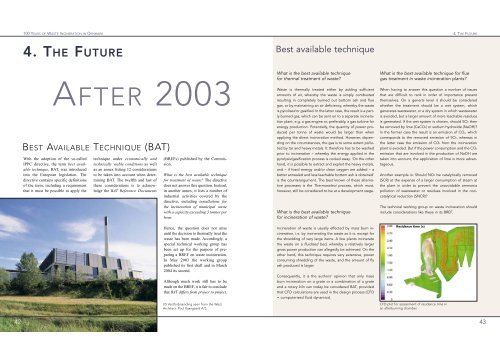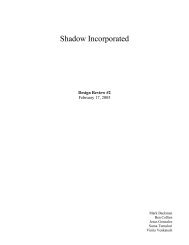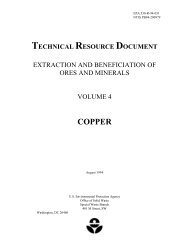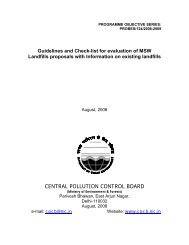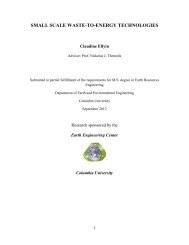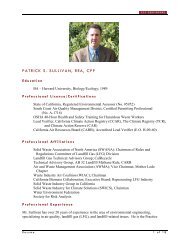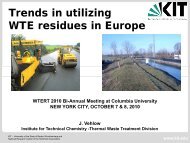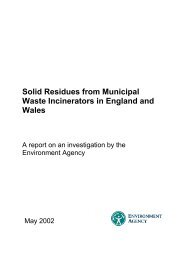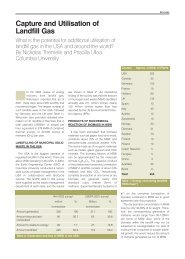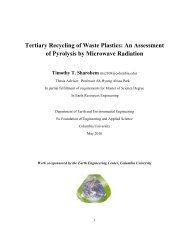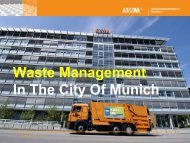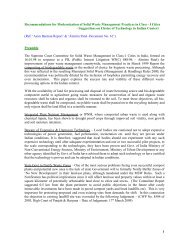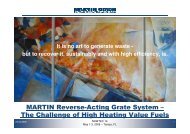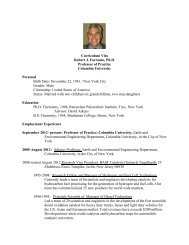100 YEARS OF WASTE INCINERATION IN DENMARK
100 YEARS OF WASTE INCINERATION IN DENMARK
100 YEARS OF WASTE INCINERATION IN DENMARK
Create successful ePaper yourself
Turn your PDF publications into a flip-book with our unique Google optimized e-Paper software.
<strong>100</strong> <strong>YEARS</strong> <strong>OF</strong> <strong>WASTE</strong> <strong><strong>IN</strong>C<strong>IN</strong>ERATION</strong> <strong>IN</strong> <strong>DENMARK</strong><br />
4. THE FUTURE<br />
4. THE FUTURE<br />
Best available technique<br />
AFTER 2003<br />
BEST AVAILABLE TECHNIQUE (BAT)<br />
With the adoption of the so-called<br />
IPPC directive, the term best available<br />
technique, BAT, was introduced<br />
into the European legislation. The<br />
directive contains specific definitions<br />
of the term, including a requirement<br />
that it must be possible to apply the<br />
technique under economically and<br />
technically viable conditions as well<br />
as an annex listing 12 considerations<br />
to be taken into account when determining<br />
BAT. The twelfth and last of<br />
these considerations is to acknowledge<br />
the BAT Reference Documents<br />
(BREFs) published by the Commission.<br />
What is the best available technique<br />
for treatment of waste The directive<br />
does not answer this question. Instead,<br />
in another annex, it lists a number of<br />
industrial activities covered by the<br />
directive, including installations for<br />
the incineration of municipal waste<br />
with a capacity exceeding 3 tonnes per<br />
hour.<br />
Hence, the question does not arise<br />
until the decision to thermally treat the<br />
waste has been made. Accordingly, a<br />
special technical working group has<br />
been set up for the purpose of preparing<br />
a BREF on waste incineration.<br />
In May 2003 the working group<br />
published its first draft and in March<br />
2004 its second.<br />
Although much work still has to be<br />
made on the BREF, it is fair to conclude<br />
that BAT differs from project to project.<br />
I/S Vestforbrænding seen from the West.<br />
Architect: Poul Kjærgaard A/S.<br />
What is the best available technique<br />
for thermal treatment of waste<br />
Waste is thermally treated either by adding sufficient<br />
amounts of air, whereby the waste is simply combusted<br />
resulting in completely burned out bottom ash and flue<br />
gas, or by maintaining an air deficiency, whereby the waste<br />
is pyrolised or gasified. In the latter case, the result is a partly<br />
burned gas, which can be sent on to a separate incineration<br />
plant, e.g. a gas engine or, preferably, a gas turbine for<br />
energy production. Potentially, the quantity of power produced<br />
per tonne of waste would be larger than when<br />
applying the direct incineration method. However, depending<br />
on the circumstances, the gas is to some extent polluted<br />
by tar and heavy metals. It therefore has to be washed<br />
prior to incineration – whereby the energy applied in the<br />
pyrolysis/gasification process is cooled away. ‘On the other<br />
hand, it is possible to extract and exploit the heavy metals,<br />
and – if fossil energy and/or clean oxygen are added – a<br />
better annealed and less leachable bottom ash is obtained’<br />
is the counterargument. The best known of these alternative<br />
processes is the Thermoselect process, which must,<br />
however, still be considered to be at a development stage.<br />
What is the best available technique<br />
for incineration of waste<br />
Incineration of waste is usually effected by mass burn incineration,<br />
i.e. by incinerating the waste as it is, except for<br />
the shredding of very large items. A few plants incinerate<br />
the waste on a fluidised bed, whereby a relatively larger<br />
gross power production can allegedly be achieved. On the<br />
other hand, this technique requires very extensive, power<br />
consuming shredding of the waste, and the amount of fly<br />
ash produced is larger.<br />
Consequently, it is the authors’ opinion that only mass<br />
burn incineration on a grate or a combination of a grate<br />
and a rotary kiln can today be considered BAT, provided<br />
that CFD calculations are used in the design process (CFD<br />
= computerised fluid dynamics).<br />
What is the best available technique for flue<br />
gas treatment in waste incineration plants<br />
When having to answer this question a number of issues<br />
that are difficult to rank in order of importance present<br />
themselves. On a general level it should be considered<br />
whether the treatment should be a wet system, which<br />
generates wastewater, or a dry system in which wastewater<br />
is avoided, but a larger amount of more leachable residues<br />
is generated. If the wet system is chosen, should SO2 then<br />
be removed by lime (CaCO3) or sodium hydroxide (NaOH)<br />
In the former case the result is an emission of CO2, which<br />
corresponds to the removed emission of SO2, whereas in<br />
the latter case the emission of CO2 from the incineration<br />
plant is avoided. But if the power consumption and the CO2<br />
emission that are involved in the production of NaOH are<br />
taken into account, the application of lime is more advantageous.<br />
Another example is: Should NOX be catalytically removed<br />
(SCR) at the expense of a larger consumption of steam at<br />
the plant in order to prevent the unavoidable ammonia<br />
pollution of wastewater or residues involved in the noncatalytical<br />
reduction (SNCR)<br />
The technical working group on waste incineration should<br />
include considerations like these in its BREF.<br />
Residence time (s)<br />
CFD plot for assessment of residence time in<br />
an afterburning chamber.<br />
42<br />
43


